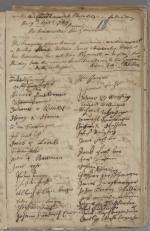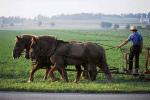![header=[Marker Text] body=[The first organized Amish Mennonite congregation in America. Established by 1740. Disbanded following Indian attack, September 29, 1757, in which a Provincial soldier and three members of the Jacob Hochstetler family were killed near this point. ] sign](http://explorepahistory.com/kora/files/1/10/1-A-52-139-ExplorePAHistory-a0a2z3-a_450.gif)
Mouse over for marker text
Name:
Northkill Amish
Region:
Hershey/Gettysburg/Dutch Country Region
County:
Berks
Marker Location:
Old US 22, 1 mile West of Shartlesville
Dedication Date:
May 15, 1947
Behind the Marker
-Corinthians 5:11
The Swiss Mennonite Brethren had been a people apart since their embrace of the teachings of Anabaptist leader Menno Simmons in the mid-1500s. Persecuted repeatedly by Swiss authorities, a number of the Brethren moved down the Rhine River into the German Palatinate and French Alsace in the 1650s. But in the late 1600s a new wave of persecution and war in the Palatinate afflicted the expatriate Swiss Brethren yet again.
In 1693 church elder Jakob Ammann insisted that the Swiss Brethren follow the biblical injunction not to associate or eat with unrepentant sinners or those who had left or been expelled from the church. Amman's insistence upon foot washing during communion services and the old Anabaptist doctrines of avoiding and shunning outsiders caused a rancorous split among the Swiss Mennonites. The small group of reform-minded Swiss Brethren that embraced Ammann's teachings became known as the "Ammanish" or Amish.
In the decades that followed, the Amish maintained strict separation from the world and expelled, then shunned those among them who lied, trimmed their beards, wore attractive apparel, married an outsider, or otherwise sinned.
To demonstrate their humility and simplicity - and to avoid any appearance of embracing the ways of the outside world lest they, too, be expelled from the community - the Amish dressed plainly and refused to adopt new technologies and changes in fashion. Untrimmed beards and long hair took on religious significance, as did the shaving of one's mustache, which had long been regarded as the mark of a soldier.
After their split from the main body of Swiss Brethren, a renewed wave of persecution against the Brethren pushed the Amish from Switzerland, Alsace, and the Palatinate south and west into France, north into the Netherlands, and northeast into Prussia and Russia. Offered assistance by Dutch Mennonites, some of the Amish sought refuge across the Atlantic Ocean in Pennsylvania.
In 1736 a small group of Amish bought an isolated tract of land along the Northkill Creek in northwest Berks County. Here Hostetlers, Yoders, Hetzlers and Millers were soon joined by Zugs and Jotters, Glicks, Kauffmans, and by Bishop Jacob Hartzler, who moved to the community in 1749. Northkill became a thriving settlement of more than 150 residents, the largest of the original Amish settlements in Pennsylvania. Here the German-speaking and pacifist Brethren built sturdy stone houses, planted apple orchards, and brought in bountiful harvests of hay, wheat, and rye from fields made rich by the German practice of plowing in manure.
The Northkill settlement was located on the edge of Pennsylvania's frontier, along the eastern slopes of the Blue Ridge Mountains, near a gap that led directly into the lands of the Lenape. At first the Amish had friendly relations with the Lenape on the other side of the mountains, but when the French and Indian War turned the Pennsylvania frontier into a killing zone, the settlement became a victim of the war.
Because the Amish were pacifists, they practiced non-resistance when a group of Lenape and Shawnee warriors attacked the Northkill homestead of Jacob Hochstetler in 1757, killing his wife and two children, then marched Jacob and his two sons to Presque Island, on Lake Erie, where they turned them over to the French. After the attack, the Northkill Amish fled east and south to safer locations. When the war was over, some of the refugees returned to Northkill, but the settlement never recovered and within a few decades was abandoned.
Presque Island, on Lake Erie, where they turned them over to the French. After the attack, the Northkill Amish fled east and south to safer locations. When the war was over, some of the refugees returned to Northkill, but the settlement never recovered and within a few decades was abandoned.
Northkill refugees helped start new Amish settlements in southern Berks and Chester counties, as well as Lancaster County, which by the late eighteenth century had emerged as the center of Amish life in North America.
"But now I am writing to you not to associate with anyone who bears the name of brother or sister who is sexually immoral or greedy, or is an idolater, reviler, drunkard, or robber. Do not even eat with such a one."
-Corinthians 5:11
The Swiss Mennonite Brethren had been a people apart since their embrace of the teachings of Anabaptist leader Menno Simmons in the mid-1500s. Persecuted repeatedly by Swiss authorities, a number of the Brethren moved down the Rhine River into the German Palatinate and French Alsace in the 1650s. But in the late 1600s a new wave of persecution and war in the Palatinate afflicted the expatriate Swiss Brethren yet again.
In 1693 church elder Jakob Ammann insisted that the Swiss Brethren follow the biblical injunction not to associate or eat with unrepentant sinners or those who had left or been expelled from the church. Amman's insistence upon foot washing during communion services and the old Anabaptist doctrines of avoiding and shunning outsiders caused a rancorous split among the Swiss Mennonites. The small group of reform-minded Swiss Brethren that embraced Ammann's teachings became known as the "Ammanish" or Amish.
In the decades that followed, the Amish maintained strict separation from the world and expelled, then shunned those among them who lied, trimmed their beards, wore attractive apparel, married an outsider, or otherwise sinned.
To demonstrate their humility and simplicity - and to avoid any appearance of embracing the ways of the outside world lest they, too, be expelled from the community - the Amish dressed plainly and refused to adopt new technologies and changes in fashion. Untrimmed beards and long hair took on religious significance, as did the shaving of one's mustache, which had long been regarded as the mark of a soldier.
After their split from the main body of Swiss Brethren, a renewed wave of persecution against the Brethren pushed the Amish from Switzerland, Alsace, and the Palatinate south and west into France, north into the Netherlands, and northeast into Prussia and Russia. Offered assistance by Dutch Mennonites, some of the Amish sought refuge across the Atlantic Ocean in Pennsylvania.
In 1736 a small group of Amish bought an isolated tract of land along the Northkill Creek in northwest Berks County. Here Hostetlers, Yoders, Hetzlers and Millers were soon joined by Zugs and Jotters, Glicks, Kauffmans, and by Bishop Jacob Hartzler, who moved to the community in 1749. Northkill became a thriving settlement of more than 150 residents, the largest of the original Amish settlements in Pennsylvania. Here the German-speaking and pacifist Brethren built sturdy stone houses, planted apple orchards, and brought in bountiful harvests of hay, wheat, and rye from fields made rich by the German practice of plowing in manure.
The Northkill settlement was located on the edge of Pennsylvania's frontier, along the eastern slopes of the Blue Ridge Mountains, near a gap that led directly into the lands of the Lenape. At first the Amish had friendly relations with the Lenape on the other side of the mountains, but when the French and Indian War turned the Pennsylvania frontier into a killing zone, the settlement became a victim of the war.
Because the Amish were pacifists, they practiced non-resistance when a group of Lenape and Shawnee warriors attacked the Northkill homestead of Jacob Hochstetler in 1757, killing his wife and two children, then marched Jacob and his two sons to
Northkill refugees helped start new Amish settlements in southern Berks and Chester counties, as well as Lancaster County, which by the late eighteenth century had emerged as the center of Amish life in North America.








